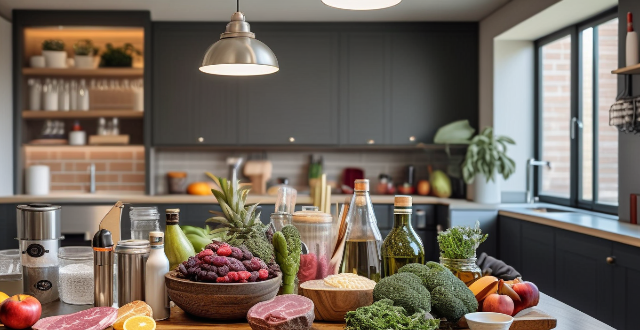Ground Shaking

What are the best exercises for a full-body workout at home ?
A full-body workout at home is an excellent way to maintain your fitness levels without the need for a gym membership or equipment. Here are some of the best exercises that you can do at home to get a comprehensive workout: 1\. Squats: Stand with your feet shoulder-width apart and your arms straight out in front of you, then lower your body by bending at the knees and hips until your thighs are parallel to the ground. Pause for a moment, then push through your heels to return to the starting position. Repeat this movement for 10-15 repetitions. 2\. Lunges: Stand with your feet hip-width apart and take a big step forward with one foot, then lower your body until both knees are bent at 90-degree angles. Keep your front knee directly over your ankle and your back knee hovering just above the ground, then push off with your front leg to return to the starting position. Repeat this movement for 10-15 repetitions on each leg. 3\. Push-Ups: Start in a plank position with your hands shoulder-width apart and your feet together, then lower your body until your chest nearly touches the ground. Push through your palms to return to the starting position. Repeat this movement for 10-15 repetitions. 4\. Plank: Start in a push-up position with your hands shoulder-width apart and your feet together, then lower your forearms to the ground so that your elbows are directly under your shoulders. Hold your body in a straight line from head to heels for 30 seconds to a minute. Repeat this movement for 3-5 sets. 5\. Burpees: Start standing with your feet shoulder-width apart and your arms at your sides, then lower your body into a squat position and place your hands on the ground in front of you. Jump both feet back into a plank position, perform a push-up, jump both feet forward so they land outside of your hands, stand up and jump into the air with your arms overhead. Repeat this movement for 10-15 repetitions.

What are the best locations to seek shelter during an earthquake ?
Earthquakes are unpredictable natural disasters that can cause significant damage and loss of life. It is important to know where to seek shelter during an earthquake to minimize the risk of injury or death. The best locations to seek shelter during an earthquake include taking cover under sturdy furniture, against interior walls away from windows, bookcases, or tall furniture that could fall on you, in open spaces away from buildings, trees, and power lines, and in underground structures such as tunnels or subway stations. If you are driving during an earthquake, stop safely and stay in your vehicle until the shaking stops. By following these guidelines, you can increase your chances of surviving an earthquake without injury.

What actions should I take immediately after an earthquake occurs ?
The text provides a list of immediate actions to take after an earthquake occurs, including dropping, covering, and holding on; staying where you are; checking for injuries and damage; turning off utilities if necessary; evacuating safely; staying informed; and remaining calm and helping others. It emphasizes the importance of adapting actions based on specific circumstances and guidance from emergency responders.

What are the most common types of climate disasters ?
The text describes the various types of climate disasters, including floods, droughts, hurricanes and typhoons, earthquakes, and wildfires. It explains the causes and effects of each type of disaster. The effects include loss of life, property damage, crop failure, water shortages, soil degradation, social unrest, economic disruption, and psychological trauma. The article concludes that mitigating the impacts of these disasters requires preparedness, adaptation strategies, and international cooperation to address the root causes and build resilience against future events.

How do I master the art of shaken versus stirred cocktails ?
Mastering the Art of Shaken versus Stirred Cocktails Understanding the Differences: - Shaken cocktails are typically frothier, due to aeration and dilution from ice. - Stirred cocktails preserve clarity and strength, ideal for spirit-forward drinks. Choosing the Right Tools: - Cocktail shakers (Boston or cobbler), jigger, bar spoon, and Hawthorne strainer are essential. Perfecting Your Technique: Shaking involves measuring ingredients, adding ice, shaking vigorously, and straining. Stirring involves similar steps but with gentle stirring in a mixing glass and using a julep strainer. Practical Tips: - Consider desired dilution and temperature when choosing preparation method. - Experimentation through taste testing and recipe adjustment is key to finding preferences.

How can I educate my family about earthquake safety and evacuation procedures ?
Educating your family about earthquake safety and evacuation procedures is crucial due to the unpredictable nature of earthquakes. Understanding the basics of earthquakes, creating a safety plan, learning evacuation procedures, conducting drills, and staying informed are all important steps in ensuring your family's safety during an earthquake. By following these steps, you can prepare your family for earthquakes and ensure they know what to do in case of an emergency.

What are the key steps in performing an earthquake drill at home ?
Earthquake drills are crucial for preparing your family to react quickly and safely during an actual earthquake. Here are the key steps to perform an effective earthquake drill at home: 1. **Preparation**: Inform family members about the purpose of the drill, assign roles, identify safe places, and secure objects. 2. **Drop, Cover, and Hold On**: Drop to your hands and knees, crawl to a safe place, and hold on until the shaking stops. 3. **Relocation Drill**: Practice evacuating safely, agree on a meeting spot, and check in with all family members. 4. **After the Drill**: Review performance, update the emergency plan, and stay informed about local warning systems. 5. **Repeat**: Conduct regular earthquake drills at least once every six months to keep procedures fresh in everyone's minds.

What's the secret to creating the perfect martini ?
The Secret to Creating the Perfect Martini is an art form that requires attention to detail, quality ingredients, and a touch of personal preference. Key elements to consider when making this iconic cocktail include high-quality gin or vodka, dry vermouth, ice cold water, and a garnish (traditionally a lemon twist or olives). Tools needed are a cocktail shaker or mixing glass, strainer, jigger for measuring, and chilled martini glass. Steps to make the perfect martini include measuring your ingredients, chilling your glassware, deciding whether to stir or shake the mixture, adding a splash of ice-cold water after stirring or shaking, straining and garnishing, and serving immediately. Personal touches such as experimenting with different types of gin or vodka, vermouth, and garnishes can add an exciting twist. By following these steps and paying attention to the details, you can create a martini that is perfectly tailored to your taste.

What tools do I need to start practicing advanced mixology ?
To start practicing advanced mixology, you will needTo start practicing advanced mixology, you will need equipment to ensure that you can you will need a variety of tools and equipment to ensure that you can create high-quality drinks with precision and consistency. The essential tools for advanced mixology include shakers, jiggers, strainers, mixing glasses, muddlers, bar spoons, fruit knives and cutting boards, bottle openers and corkscrews, ice buckets and tongs, pour spouts, and miscellaneous tools such as citrus peelers, channel knives, ice scoops, and juicers.

What's the best way to infuse alcohol with fruits or spices ?
Infusing alcohol with fruits or spices is a great way to add flavor and complexity to your drinks. Here are the steps to do it right: Materials Needed: - Alcohol of your choice (vodka, rum, gin, etc.) - Fresh or dried fruits/spices - Clean glass jar or bottle with a tight-fitting lid - Fine mesh strainer or cheesecloth - Funnel (optional) Steps to Infuse Alcohol: 1. Choose Your Ingredients: Pick high-quality fruits and spices that complement the flavor profile of your chosen alcohol. Popular combinations include vodka with citrus fruits or jalapeño, rum with tropical fruits or cinnamon, and gin with juniper berries or lavender. 2. Prepare Your Ingredients: Wash and chop fresh fruits into small pieces. For spices, use whole spices like cinnamon sticks or crush them slightly to release more flavor. Dried fruits can be used as they are. 3. Infusion Process: Fill your clean glass jar or bottle with the prepared fruits/spices, leaving about 1/4 of the container empty at the top. Pour in the alcohol until the fruits/spices are fully submerged. 4. Seal and Shake: Close the jar tightly and shake well. Store it in a cool, dark place, shaking it occasionally over the next few days to help release the flavors. 5. Taste Testing: After about 3-5 days, taste your infusion. If it's not strong enough, reseal and let it sit for a few more days. The longer it sits, the more intense the flavor will become. 6. Straining and Bottling: When you're satisfied with the flavor, strain the mixture through a fine mesh strainer or cheesecloth into a clean jar or bottle. Use a funnel to transfer it without spilling. 7. Enjoy! Your homemade infused alcohol is now ready to be enjoyed in various cocktails or served neat over ice. Remember, the quality of your ingredients matters greatly. Always use fresh fruits and high-quality alcohol for the best results. Cheers!

Can asymptomatic individuals spread COVID-19 ?
Asymptomatic individuals can spread COVID-19, making preventive measures crucial.